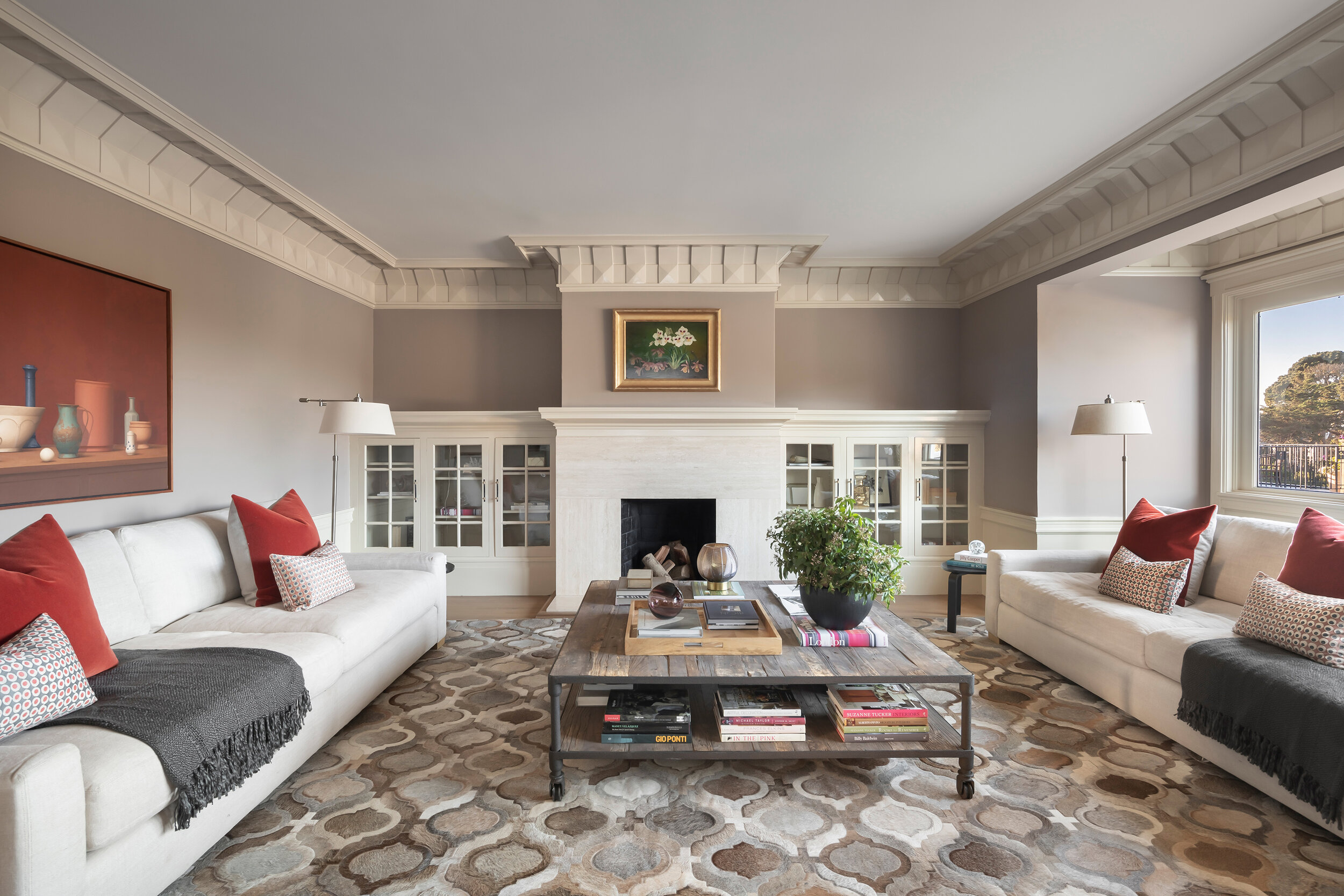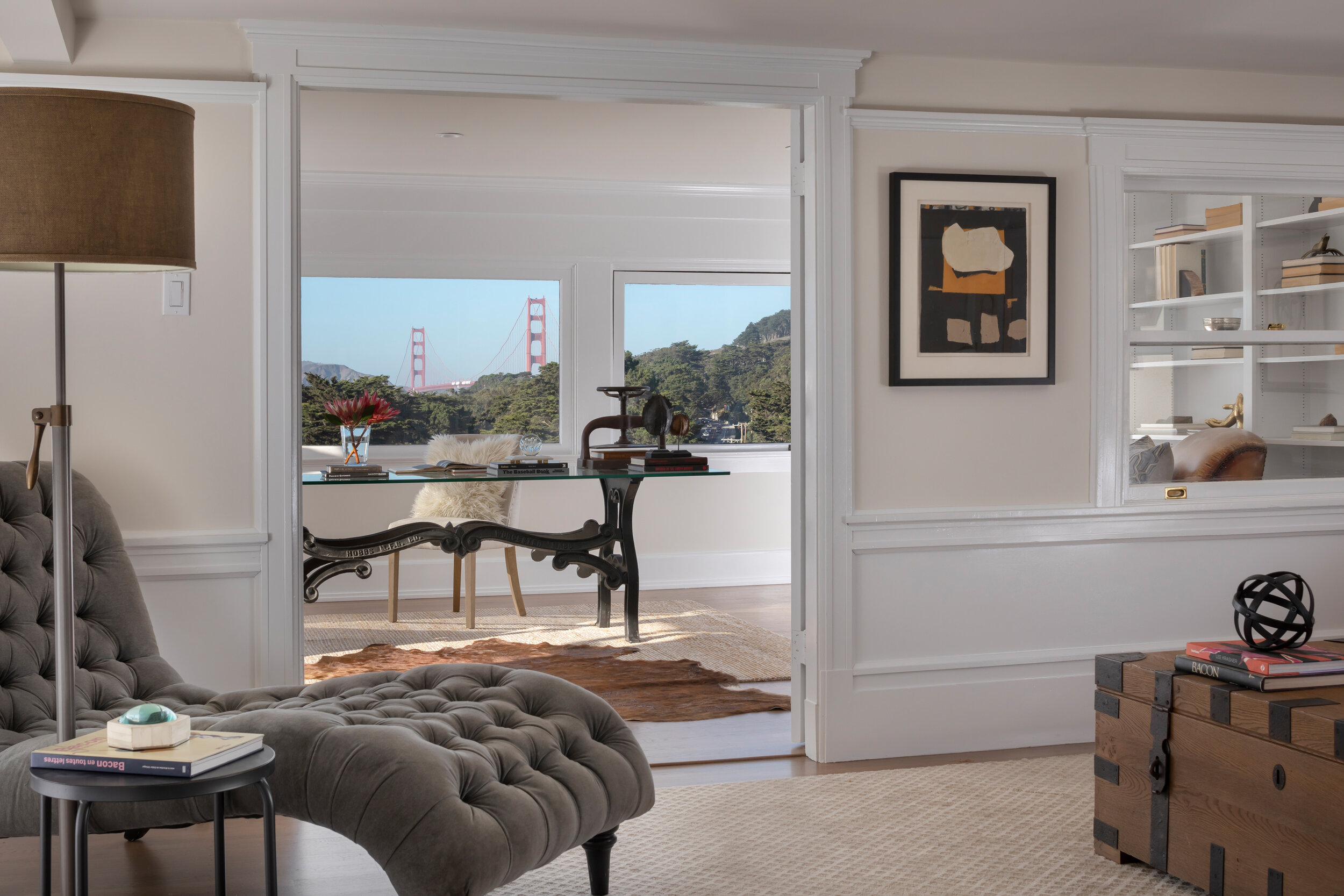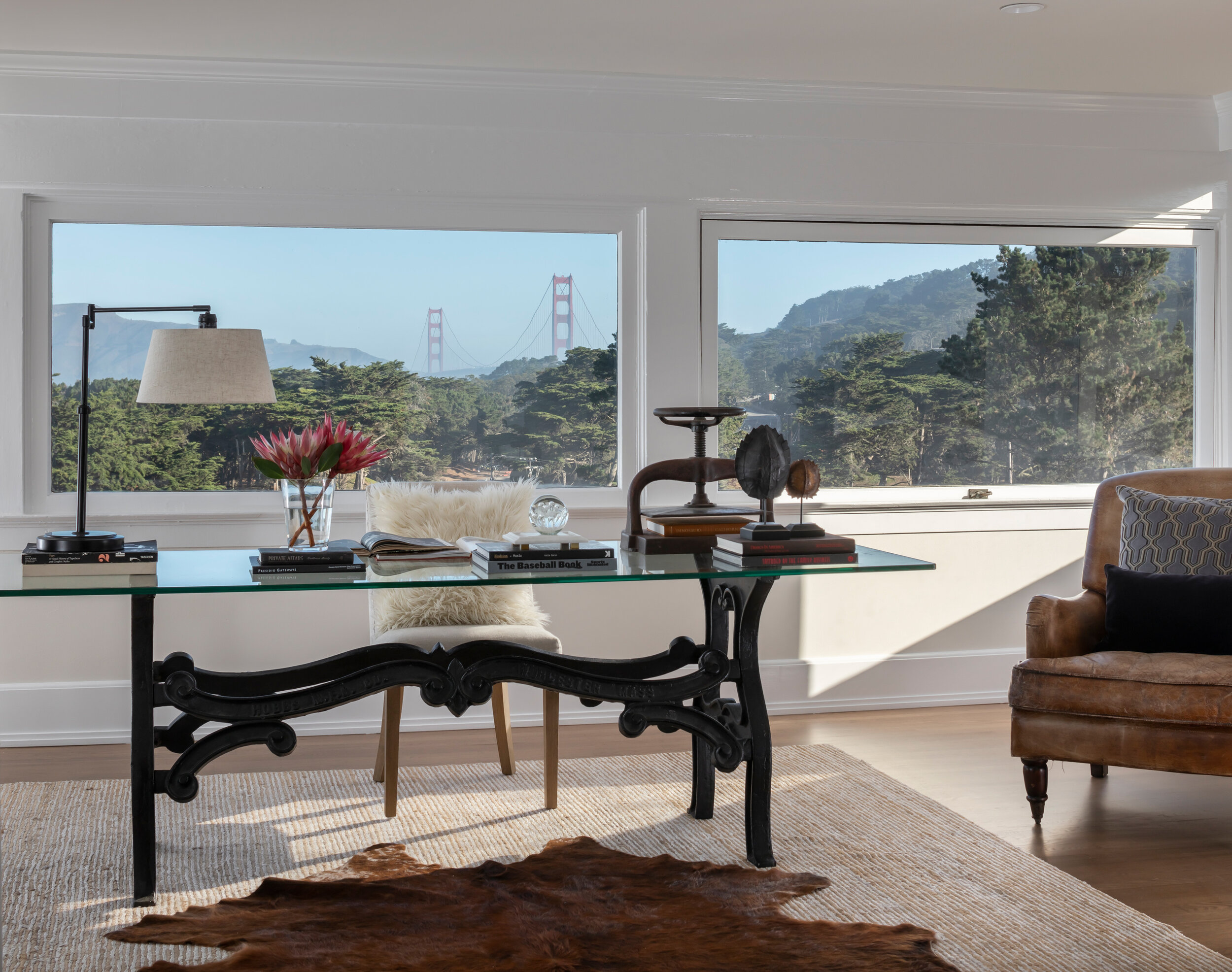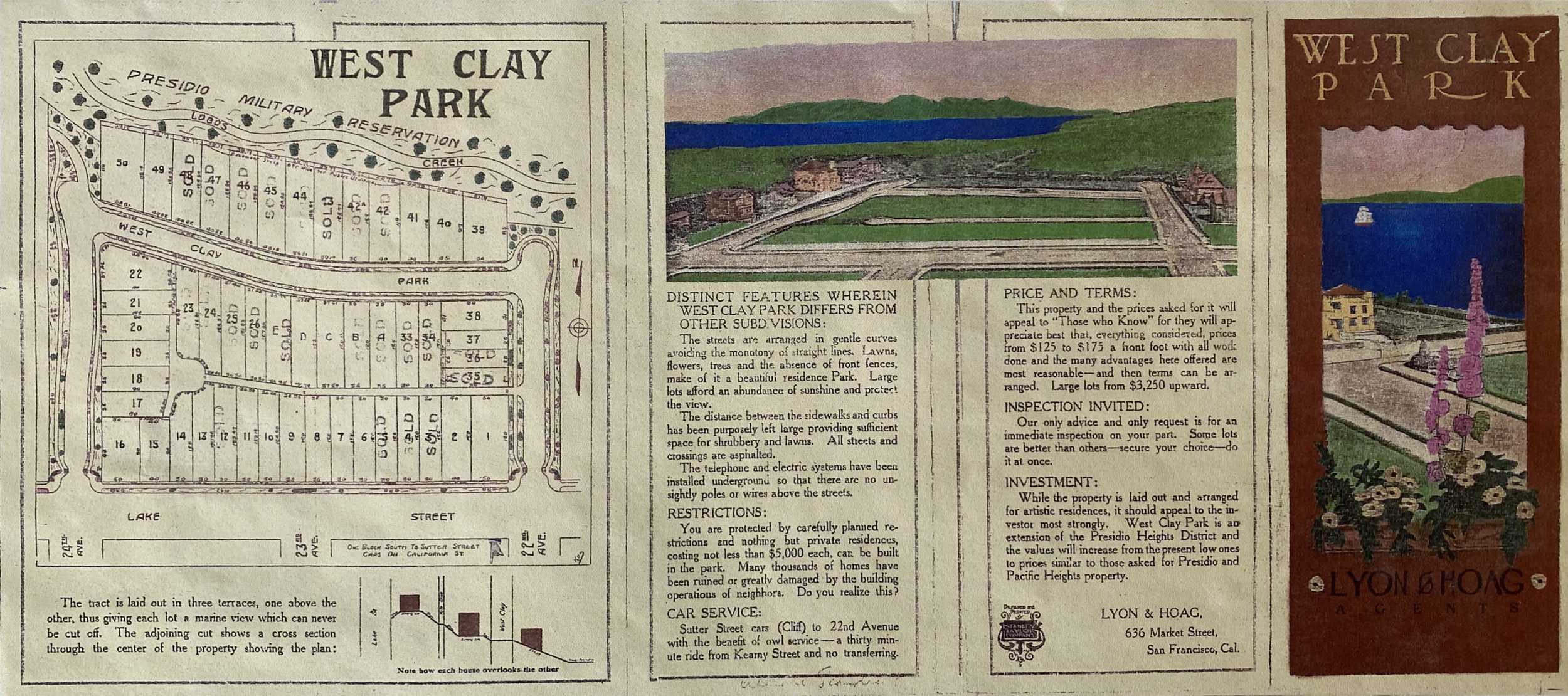Historic West Clay Park Residence
SOLD FOR $7,000,000
An Introduction
34 West Clay Park is an incredible opportunity to own one of only fourteen private homes along the enclave’s Golden Gate National Recreation Area border, one of San Francisco’s most coveted locations. Situated along Lobos Creek Valley and connecting to the Baker Beach trailhead, the immediate proximity to parkland and coastal living captures the globally recognized Northern Californian experience. Built in 1912 during San Francisco’s residence park movement, this four-level home welcomes gracious family living with views of the Golden Gate Bridge framing an inspired town and country lifestyle.
































Property Details
Within the bustle of the city, 34 West Clay Park captures the essence of residential park living. Upon entering the residence, one is immediately drawn to the architectural elegance and detailing of the classical interior millwork. The entry foyer leads to a spacious living room that is accented by a wood burning fireplace and large windows looking directly out to the Presidio. This entertaining location of the home connects directly to a large outdoor terrace with built in seating to enjoy the views of Lobos Creek Valley and the Golden Gate Bridge towers. Along the opposing side of the main level is a dramatic wood paneled formal dining room with a window seat, china cabinetry, and a wood burning fireplace. The kitchen connects directly off this room to allow for culinary activity in a more traditional closed-door plan. This floor is completed by a jewel box powder room.
The first upper level of the residence is comprised of three bedrooms. The master suite is situated along the northern side of the floor with large picture windows that afford beautiful outlooks to the Marin Headlands and Golden Gate Bridge. This bedroom enjoys two sitting areas, one with a wood burning fireplace and the other along the view window line. Two additional bedrooms comprise this level. The top floor level of the home is accessed through a glass paned door and up a stairway accented with luxurious natural wood wainscoting. On this second upper level, a large en suite bedroom faces south and is accented with a natural redwood, box beam ceiling. A large family room leads to a sunroom office, bathed in natural light from the enclosure of the panoramic view windows. A wood oven adds ambience to this charming area.
The lower level of the home is accessed from a stairway off the entry foyer. This level of the home has a large bedroom and a den with wood burning fireplace. Laundry room, storage and a half bath complete this floor. The Golden Gate Bridge view two-car garage is accessed from the den, as is the rear outdoor terrace with built-in seating. From the terrace, the inviting lower yard is accessed down a series of stairs. This special part of the property enjoys a flat lawn surrounded by tasteful landscaping and more built-in seating. Enjoying privacy and immediate outlooks to Lobos Creek Valley, this peaceful location makes for the quintessential nature experience uniquely offered by the residence.
West Clay Park: A Quintessential San Francisco Neighborhood
Classic San Francisco. Community. Natural beauty. These are some of the many words that the neighborhood of West Clay Park evokes. As one of a number of residential parks that were successfully developed in San Francisco, the West Clay Park neighborhood was immediately recognized by city residents as a unique opportunity to enjoy the benefits of suburban living within the city limits. The natural beauty afforded by this location cannot be overstated. It is no wonder that Ansel Adams and his family were longtime residents of the neighborhood. With direct access to Baker Beach and the Land’s End hiking trails, scenic biking trails and golf at Lincoln Park, and surfing for the brave at heart, activity filled days await. For the more culturally inclined, the Legion of Honor museum is nearby, housing the city’s European art collections and important traveling shows. The neighborhood is filled with local stores and the business district of Clement Street has numerous restaurants. West Clay Park is an eco-system unto itself, offering the traditions and small town feel of San Francisco’s days gone by. Link to neighborhood website HERE
Sales Brochure for West Clay park (1910)
A History of the Early 20th Century Residential Park
Influenced by nineteenth-century American suburban ideals and the City Beautiful movement, San Francisco developers created eight subdivisions of spacious and thoughtfully designed single-family houses surrounded by classically inspired landscaping between 1906 and 1940. Called “residence parks” to emphasize the park-like setting, a larger parcel was developed to form a private enclave separate from the city’s thoroughfares. These subdivisions laid out the streets and lots to follow the existing topography and create a setting that fulfilled the ideal of domestic life in a semi-rural environment.
The origins of residence parks can be found in earlier movements to create master-planned communities called “garden suburbs.” Robert A. M. Stern, in his magisterial book, Paradise Planned, identified the existence of at least twenty garden suburbs built before 1900 in the United States, and 145 by 1920. San Francisco’s residence parks are what Stern calls “garden enclaves,” neighborhood versions of a garden suburb, sharing many of the same ideals and traits, but enclosed within the city limits. These communities promised a “park in the city,” not a house in the suburbs.
On March 30, 1910, the Boston Investment Company filed a subdivision map with the city, drawn by engineer William B. Hoag, for West Clay Park. The name “West Clay Park” referred to a new street created by the developers, West Clay, chosen to perpetuate an association with Clay Street in Presidio Heights, 22 blocks east. The site slopes downward from Lake Street to Lobos Creek, which allowed the developers to terrace the tract and provide many of the houses with marine views of the Golden Gate to the north. In January 1911, the real estate agency Lyon & Hoag claimed West Clay Park was “The Most Successful Real Estate Sale of 1910.” By March 1911, only 14 of the original 50 lots were left. Whether or not West Clay Park was the most successful real estate sale of 1910, it quickly achieved local prominence. Today, this neighborhood is known for its tight knit community lifestyle, one that carries forward the traditions and small town feel of San Francisco’s post-war era. A rare opportunity to experience a time gone by in the city’s modern era.




Offered at $6,250,000
One of Only Fourteen West Clay Park Homes Adjacent Lobos Creek Valley
5 bd. / 5.5 ba. / 2 Car Garage
Views of the Golden Gate Bridge
Classical Interiors on Four Levels
Multiple Outdoor Living Spaces: Walkout Terrace from Living Room, Lower Terrace, Landscaped Garden
Wood Paneled Formal Dining Room
Master Suite with Panoramic Views
Flexible Floor Plan with Multiple Family Rooms and Guest Suites
Immediate Access to Golden Gate National Recreation Area
Ideal Residential Park Neighborhood within the City Limits
DIGITAL BROCHURE
34 West Clay Street




